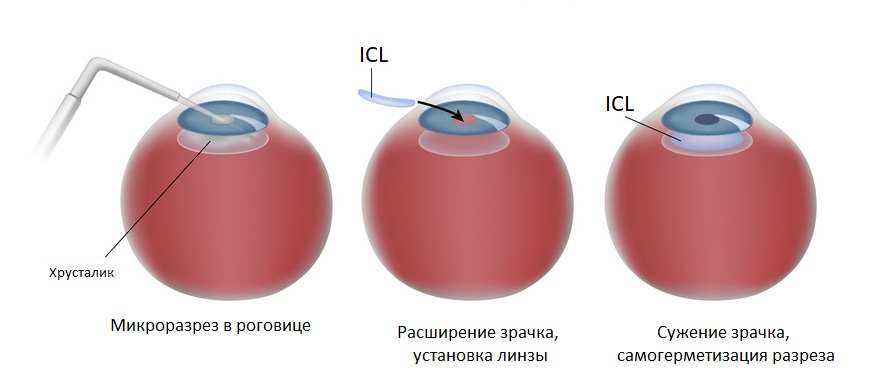Implantable Intraocular Contact Lenses (ICL STAAR and other)
In people with high degrees of refractive errors, as well as those who have insufficient to perform the procedure safely thin cornea or keratoconus, laser vision correction is not advisable. These patients are offered alternative methods of correcting the pathology of vision. One of these methods, successfully practiced in the world of ophthalmology for more than 10 years, is the implantation of ICL (implantable collamer lens), an intraocular lens of the Swiss-American company STAAR or other manufacturers.
Thanks to them, today more than 850 thousand patients in the world have the opportunity to enjoy good eyesight without glasses. ICL STAAR allow to get rid of myopia up to -20.0 D, hyperopia up to +10.0 D and astigmatism up to 6.0 d.

What is ICL STAAR
ICL STAAR is a specially designed lenses, which are made of a unique patented material "Collamer®" - a copolymer of human collagen, which does not cause a reaction and can stay in the eye all life. Therefore, there are two ways to decipher the abbreviation ICL - Implantable Collamer Lens (patented name) and Implantable Contact Lens (from other manufacturers).
These lenses, often called "live", deserve this title, as one of the first were created from a material so close to human tissues.
The STAAR lens is so thin and soft that it bends easily and in just minutes can be implanted into the eye through a microtunnel formed in the cornea.
Inside the eye, such a lens is straightened in the eye fluid and occupies the necessary position between its own lens and iris. Since the natural biological lens of the eye is preserved, such lenses are also called phacic (posterior chamber).

ICL STAAR works like a normal contact lens. The only difference between them is only the location. ICL is located inside the eye, it is invisible and corrects vision once and for all, without causing a sense of presence inside a foreign body. In the eye, such a lens is implanted for life, but if necessary, it can be removed without disruption of intraocular structures and its anatomy. After surgery, vision is restored almost immediately.
Before implantation
The procedure of implantation of ICL lenses is very fast and painless, however, before it the patient undergoes a thorough and detailed examination of the eyes. In the process of diagnosis, the parameters of the lens necessary for the patient, including its size and optical power, are calculated.
Sometimes, according to the indications, before surgery, preparatory measures can be carried out (a week before implantation): in the iris, the surgeon forms a small laser puncture (1 mm), which will provide in the future, after the operation, free circulation of intraocular fluid and exclude the iris-lens block (despite the fact that the center of the lens is micro-opening).
The progress of the surgery
The procedure for installing the lens STAAR occurs under local anesthesia with anesthetic drops. They provide complete pain relief, so during the operation, patients do not feel even slight discomfort.
НAt the initial stage of the operation the periphery of the cornea, the surgeon creates, microtunnel. A special syringe-injector through it is introduced a rolled lens, which is then straightened and fixed in front of the lens, just behind the iris (in the rear chamber). This position of the lens is the most physiological, so patients with high degrees of myopia and astigmatism get the highest possible acuity and the best quality of vision. In this case, the patient's own lens is not removed, which makes it possible to focus the eye naturally at close and long distances, saving the patient from glasses.
The operation is performed in one day mode, lasts only 10 minutes, and after 2 hours the patient can leave the clinic. Return to the usual way of life will turn out almost immediately, enjoying the high quality of vision.
Video of ICL-implantation
Who is a candidate for implantation of an ICL
If we talk about the correction of refraction disorders in patients with keratoconus - that, in addition to intrastromal rings, the installation of intraocular implantable lenses is the second most popular method and can be combined with corneal segments. The question of the possibility of ICL implantation and the feasibility of this step can be solved only by the attending physician after a full examination of the patient's eyes.
In addition to low vision in keratoconus, ICL can be used to correct most refractive errors: hypermetropia up to +10.0 D, myopia up to 20.0 D, astigmatism up to 6.0 d.
The method of ICL implantation is preferable for patients with healthy lens, in which it is impossible to perform laser vision correction:
- Due to the high degree of pathology of vision;
- With a thin cornea or dry eye syndrome, when it is impossible to carry out laser correction (including ReLEx SMILE);
In addition, this refractive surgery is suitable for patients with wide pupils, when the quality of night vision are special requirements.

The benefits of ICL
Ophthalmologists confirm that the implantation of the STAAR ICL has many advantages before other methods of correction of refractive error:
- ICL is a method of choice when it is impossible to perform laser correction;
- ICL implantation corrects high degrees of myopia, hyperopia, astigmatism;
- It provides high quality of vision, long-term and stable results;
- When performing the operation, there is no need for large incisions, it is carried out through a self-sealing microtunnel subsequently, which does not require suturing;
- The lens is completely invisible in the eye;
- The location of the lens in the eye behind the iris is the most physiological. It does not come into contact with the iris and cornea, so it can not cause dystrophic tissue changes;
- The ICL material is a patented biocompatible polymer, or rather a copolymer of human collagen that best interacts with the eye.
The material contains a certain chromophore that filters out the UV rays of the solar spectrum, which protects the natural lens and retina from its harmful effects. Due to this, the process of clouding of the lens and macular degeneration slows down. This is especially important for patients with a high degree of myopia, in which cataract and macular degeneration can develop even at a young age
The safety and efficacy of ICL has been proven by numerous clinical trials. In addition to Russia and Europe, the method has been certified by the FDA and is widely used in many ophthalmic clinics around the world, including our clinic in Moscow.
Risks of implantation ICL
After implantation of posterior chamber FIOL, complications such as cataract and pigment dispersion syndrome are most often observed. They develop due to contact of a foreign body with the lens or iris of the patient, which takes place at hypermetropia due to the narrow rear chamber of the eye or in case it is not extortion of the size of the lens.
Prices for the installation of implantable contact lenses
The cost of surgery in our specialized ophthalmological center is 180 000 - 200 000 rubles (2 600 - 2 900 $).
Feedbacks after surgery
Below in the comments you can read other reviews of people who have already passed the ICL installation procedure or leave your own opinion.




Thanks.
Yes, ICL implantation can be considered as a method of correction after laser refractive operations, when the corneal thickness does not allow to do it by other methods.
The only point - vision should be stable for one year (or better - two years).
Also, the installation of IOL is not carried out during pregnancy and lactation.
I had phakic lens STAAR (six months after crosslinking) implantation.
In my mind, I am satisfied, but the price is 50% more than the laser, and the cross-linking - all 2 times in common.